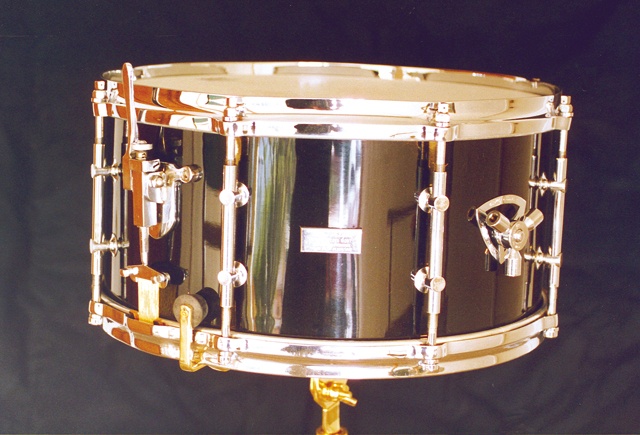
Being a student of vintage drums for nearly 20 years, I am often asked, “What is the rarest vintage drum?” I know I will get a lot of arguments here, but I believe the Gene Krupa Billy Gladstone Custom Drum is the winner, hands down. Webster’s defines rare as “not frequently encountered; scarce; uncommon; unusually good; excellent.” Since Billy Gladstone handcrafted only 60 of his custom drums back in the 1950s, any of his drums meet that definition.
As many of you are probably aware, Gladstone designed his drum to meet very specific criteria. Since all drumheads back in those days were calfskin, Gladstone wanted a drum that could be quickly and easily tuned, both the top and bottom heads, from the top tension rod. Unlike plastic heads of today, calfskin heads reacted to climatic conditions and were in constant need of adjustment. By designing a tuning system that would tension both heads separately or in unison from the top, the drum would not have to be turned over either before or during a performance.
Gladstone filed for a patent in 1936 for his unique design. Lacking manufacturing and distribution facilities, Gladstone formed a partnership with the fledgling Fred Gretsch Manufacturing Company and introduced the Gretsch Gladstone drum at the New York Musical Trades Convention in 1937. Though not an overwhelming success, the drum caught the fancy of many leading drummers at the time, such as Chick Webb, Jo Jones, and O’Neal Spencer.
Unfortunately, the metal shortages of World War II put an end to such an elaborate drum design, so the drum was shelved. For whatever reason, at the end of the war, Gretsch decided to discontinue the Gretsch Gladstone drum. Undaunted, Gladstone began manufacturing his drums for specific drummers on a custom basis. This was unheard of at the time, so the market was limited.
Still, with Billy Gladstone’s reputation as both an incredible performer and inventor, the word got out. Leading kit drummers like Krupa, Louie Bellson, Cozy Cole, Morey Feld (Benny Goodman’s drummer), Shelly Manne and Buddy Rich, as well as noted symphonic percussionists like Buster Bailey, Mickey Bookspan, Morris Goldenberg, Arnold Lang, and Arthur Press quickly entered their names on Gladstone’s prestigious waiting list.
Gladstone was very particular about what went into his drums. The result was a protracted manufacturing process. The curing of the gut that he sometimes used as snares would take weeks. The drums not only had to be perfect, but as Ted Reed once told me, “Billy wouldn’t let anybody touch the drum until it got into the rightful owner’s hands.” With all this mystique, it is no wonder that these drums command the highest prices among vintage drums.
So why is the Krupa drum more valuable? I won’t get into the argument of who was the best player or most notable (though my personal favorite was Buddy Rich). Gene Krupa commissioning Billy Gladstone to build a custom snare was significant. Like today, endorsement deals were actively sought after by both manufacturers and artists. Manufacturers touted their wares “as played by” artists who received free equipment and occasional royalties. Between December, 1966, and December, 1967, Buddy Rich switched his endorsement four times, from Rodgers, to Vox, to Fibes to Slingerland. Rich was not only fickle with his loyalty but also very difficult to deal with. Bill Ludwig, Jr. is quoted as saying his six most dreaded words were “Buddy Rich is on line two.”
Most all the famous drummers in the mid-1900s changed brand loyalty, all but Gene Krupa, that is. Prior to his first professional appearance with Benny Goodman, Krupa played an old set of used Ludwigs. To give his son a good start, Gene’s father tried to order a new set of Ludwigs direct from the factory in Chicago. Unfortunately for the Ludwig Drum Company, the sales manager refused to sell direct. The elder Krupa called the Slingerland factory and explained to H.H. Slingerland that his son’s career was about to be launched. Mr. Slingerland saw the vision and an endorsement deal was set.
That endorsement deal lasted a lifetime, serving both Krupa and the Slingerland drum company very well. Krupa rarely turned in his drums to the factory for a new set, so documented Krupa sets are very rare. I’m sure Krupa had many opportunities to switch to another brand, but for whatever reason he remained loyal. So loyal that almost every photograph taken of Krupa shows him sitting at his big white marine pearl Slingerland set. I have seen only three exceptions: one with a set of Gretsch, another behind a Gretsch Gladstone snare, and one of him playing his Billy Gladstone Custom snare (with his Slingerland kit) at a 1963 recording session in New York City.
For Krupa to substitute his snare with a non-Slingerland drum was surely seen as a traitorous by the factory head office. Still, it speaks for Krupa’s fascination for Billy Gladstone and his unique custom snare drums. The feeling was mutual, by the way. A plaque on the side of Krupa’s Gladstone is inscribed “Gene Krupa The World’s Most Renowned Drummer From Billy Gladstone.”
